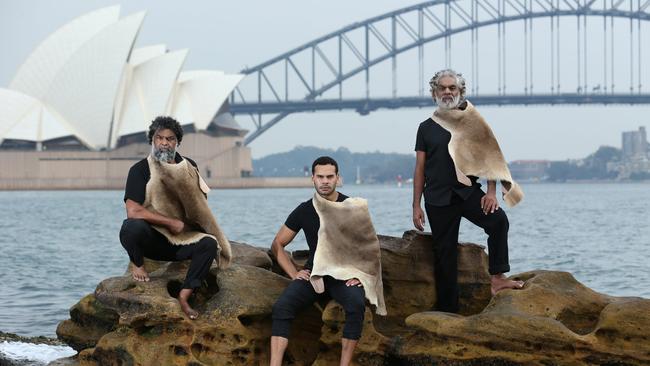Theatrical bridge to a revised view of Australia Day history
A new play about the arrival of the First Fleet reimagines the reaction of early Indigenous Australians to colonisation.

Almost 240 years ago, seven men wearing suits and ties gathered on the shores of Sydney Harbour as the hulking vessels of the First Fleet sailed by. Tasked with choosing how to respond to this event, Australia’s first law men began to debate how to respond.
At least that’s how Muruwari playwright Jane Harrison has imagined the arrival of the First Fleet in her new production The Visitors, presented by indigenous theatre company Moogahlin Performing Arts and premiering next week at the Sydney Festival.
Acclaimed for her plays Stolen and Rainbow’s End, Harrison’s latest telling of indigenous Australia imagines the response from clan leaders, performed by a cast including John Blair, Damion Hunter, Colin Kinchela and Nathan Leslie, to the fraught beginnings of modern Australia.
There are no first-hand accounts from an indigenous perspective from January 26, 1788, so Harrison has filled this gap with characters — people with their own opinions, flaws and biases — to explain the indigenous custom that escaped the narrative many Australians think they know.
“Colonisation is something Aboriginal people are always portrayed as being victims of, but what if we were to look at it in a different way and to think that Aboriginal people were following their own protocols of welcoming strangers to their country,” Harrison said.
“I’m always amazed at the overwhelming sense of generosity I feel when I hear a welcome to the country. Their country, language and children were stolen but amazingly there still remains a sense of generosity. I wanted to honour that by presenting a new way of looking at colonisation that explains the significance of January 26 to both black and white modern Australians.”
Working closely with the co-artistic director of Moogahlin, Frederick Copperwaite, Harrison began imagining the lives of Aboriginal people prior to 1788.
“It was important to see these characters before their minds had been colonised. The seven elders were operating as usual, but as the boats dropped anchor, it was like a grenade had been thrown,” Harrison said.
“One man questions the set of responses and he forces the others to look deeper into their protocols and precedents. Together they hint that stories are usually told by the winners of history, so they decide they will observe, listen and unpack these desires to send the visitors on their way.”
Harrison’s story succeeds in presenting the seven elders as “civilised men” who are intelligent, knowledgeable, logical and reasonable. In her retelling of history, the idea of the noble savage is flipped on its head — hence the choice of clothes for the cast.
“There are a whole lot of stories emerging that show the strengths and resilience of Aboriginal Australians,” Harrison said.
“People realise now that Aboriginal people have a huge amount of knowledge and there is a hunger and thirst to see it. It’s important to reimagine what it would have been like and what they were going through.”




To join the conversation, please log in. Don't have an account? Register
Join the conversation, you are commenting as Logout